
Georgia
For a full scale picture, please click on the picture shown !
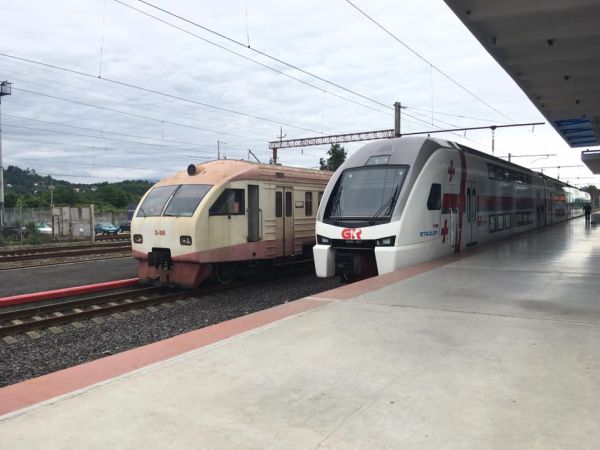
A view from the main station of Batumi, Georgia. The train on the left is an old ER2 or ER1 built by RVR in Riga, Latvia during
communist times, but it has received a completely new driver's cab. The train on the right is a Stadler KISS GRS "Eurasia", built by
the Swiss company Stadler Rail. Stadler produced a series of these trains for the purpose of running between Moscow city and airport
in Russia as "Aeroexpress". It is a slightly modified version of Stadler's double decker KISS regional train. But the private company
Aeroexpress ran out of money and could not pay all the trains it had ordered, so some of them were sold to Azerbaijan Railways and
Georgian Railways.
Picture from Batumi 19.6.2017 by Timo Varshukov.

Not all the trains in Georgia are in a perfect shape. This ER2 was built in the 1960s and it looks like it hasn't been renovated ever
since. Picture from Tbilisi 11.2.2009 by Johan Ehnberg.
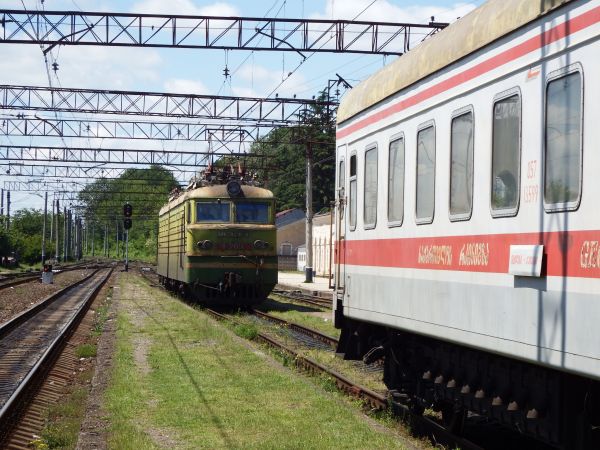
Express train from Tbilisi to the city of Kutaissi in 2019 equalled to just one coach, which was taken along on a train going somewhere else
and then left for something like an hour to stand all by itself alone at the small station of Rioni, less than 10 km away from Kutaissi.
Then after about an hour of waiting a huge double locomotive of the class VL11 (Vladimir Lenin 11) came to fetch it and take it to Kutaissi.
The area was still known to have guerrilla activity opposing the army.
This is the VL11 coming to fetch the one coach "express train".
The locomotive class VL11 is a rarity even in the former Soviet Union. It's a further developement of the VL10. It was built from 1975 onwards
but not at the usual building factories, but instead at Tbilisi electric locomotive builder plant (Тбилисский электровозостроительный завод).
It's a double locomotive, but also three unit versions exist, the third unit then without driver's cabs. It's built for 3 kV DC only, has a
max speed of 100 km/h and a modest power output of only 4600 kW (continuous), not much for a big double locomotive. They have been in use in
Russia, Ukraine, Georgia and Azerbaijan. Ukraine started rebuilding and modernising its VL11 fleet before the war, but the current situation
is unknown.
Picture from Rioni Georgia 13.5.2019 by Adrian Gray.
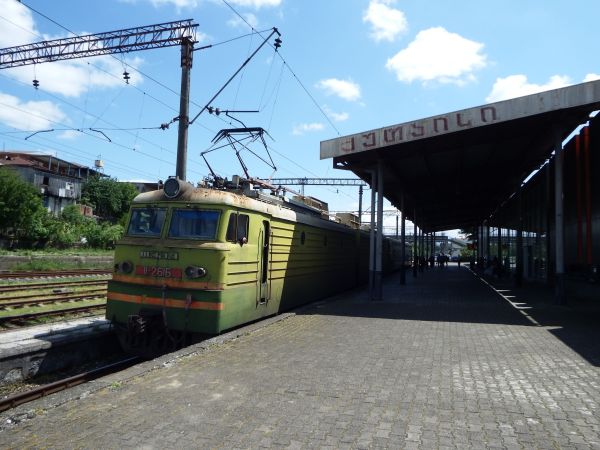
Here the huge VL11 double locomotive has finally brought its one and only coach to the station of Kutaissi.
Picture from Kutaissi Georgia 13.5.2019 by Adrian Gray.
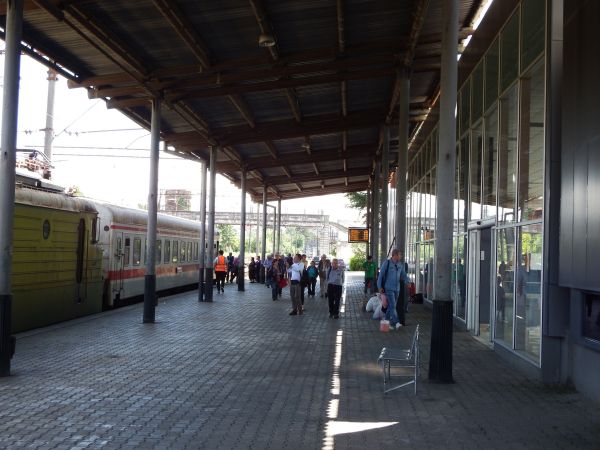
The station of Kutaissi. Train from Tbilisi has just arrived a moment ago.
Picture from Kutaissi Georgia 13.5.2019 by Adrian Gray.
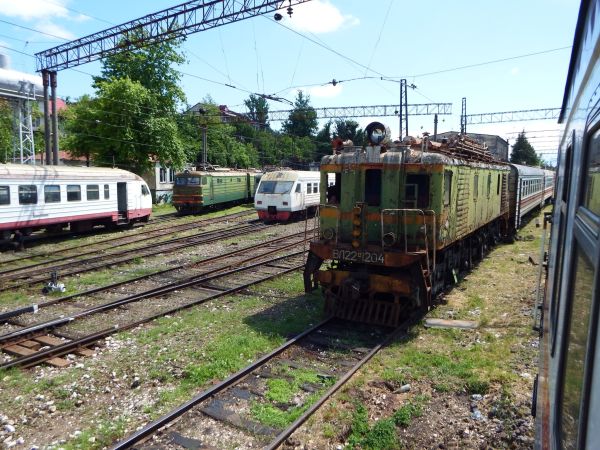
A view from the station of Kutaissi. Look at the old locomotive close by on the right hand side. It's a VL22 (Vladimir Lenin 22) built in the
1930s. It doesn't even have any windscreen panes left, yet it still seemed to be the machine which is doing the shunting duties at Kutaissi.
According to somebody who knows the local environment, these machines were only "very recently" taken out of daily use. These machines used
to be hauling long express trains as recently as 2006-07. But not in as desolate condition as this one.
The mostly white local trains are partly modernised ER2 trains built in Riga, Latvia during the Soviet years. They have just received totally new
driver's cabs. According to the latest rumours in 2022 there's just one local train service left from Kutaissi with one ER2 train going to a
fairly close by village and coming back. This happens twice a day.
The green locomotive to the left at the back of the picture is yet another VL11 double locomotive.
Picture from Kutaissi Georgia 13.5.2019 by Adrian Gray.
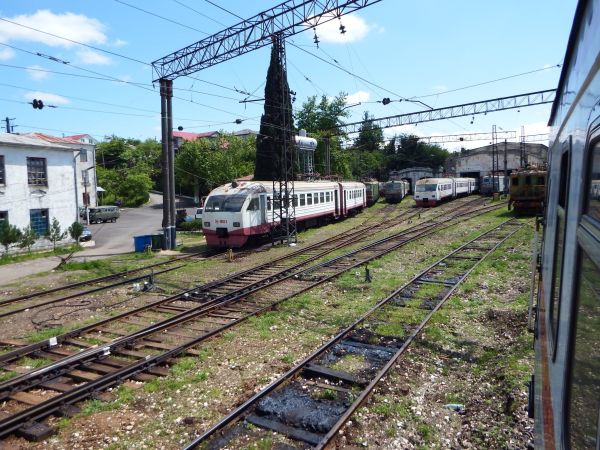
Another view from the station of Kutaissi. This shows better the Soviet style ER2 local trains which have received new front ends.
Picture from Kutaissi Georgia 13.5.2019 by Adrian Gray.
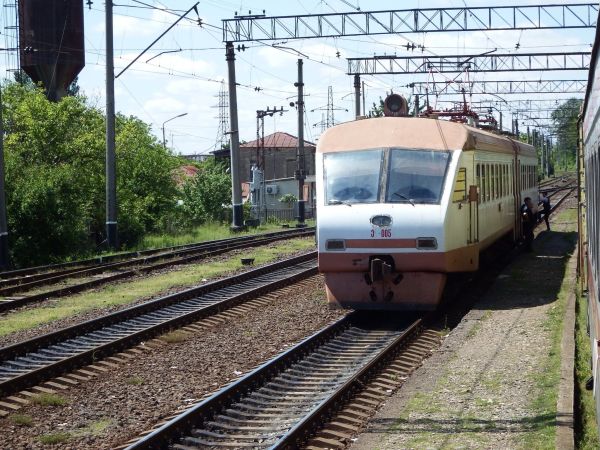
A closer look at one of the partly modernised ER2 trains of Georgia. Officially this belongs now to the class ER2M where the M stands for
modernised. But the modernisation differs a lot from train to train. This one has received totally new driver's cabs, which however look
a bit "homemade". It has also received new plating on its sides since it is now partly missing the typical riffled structure typical of
ER trains. And an ER2 usually always consists of at least four to six coaches, sometimes more than ten. And now this one has just two.
Picture from Rioni Georgia 13.5.2019 by Adrian Gray.
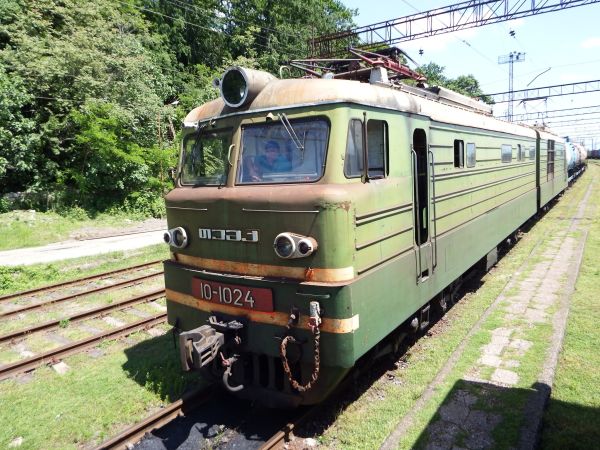
A VL10 double locomotive of the Georgian Railways. The VL10 is a close relative of the VL11 shown above. It was also built by the Tbilisi Electric
Locomotive Works, but not only there but also at the Novocherkassk Electric Locomotive Plant. From Novocherkassk these were much, much more common
all over the former Soviet Union than the VL 11 built only in Tbilisi. This model VL10 was built in 2881 copies and used in Russia, Ukraine, Armenia,
Georgia and Azerbaijan. Like the VL11, it was designed only for 3 kV DC. It was built 1961 to 2005 (sic!!!) more or less unchanged. Novocherkassk
built it from 1961 to 1976 and the Tbilisi factory stopped producing them only at 2005.
Picture from Rioni Georgia 13.5.2019 by Adrian Gray.
Borjomi-Bakuriani narrow gauge railway "Kukuschka"
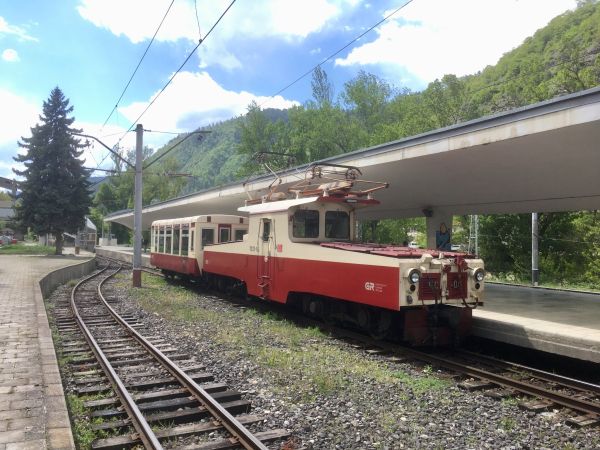
Between the town of Borjomi down by the main line railroad and the ski resort of Bakuriani a 900mm gauge railway used to operate. The small train
was known by its nickname "Kukuschka", little cuckoo. The line had been built since 1897 and the first train ran in 1902. The line is 37,2 km long
and it climbs up quite a lot. Borjomi is located at 820 m above sea level and the ski resort of Bakuriani is at 1700 m above sea level. Although
the distance between the endpoints is just 37 km, it still took the small train about 2,5 h to run the line from end to end, the average speed
being 15 km/h. Originally the line was constructed for transporting andesite from a mine close to Bakuriani using a steam locomotive. The line
was electrified in 1966 using 1500 V DC. Ever since it was operated by these small electric locomotives of the type ChS-11 built by Škoda in Czechoslovakia.
Since 1991 the railroad was only used for transporting tourists and local residents and the andesite ore transport was stopped. The whole line
stopped working in 2022 because of the terrible state of the tracks and lack of money to rebuild the line totally although an agency called
Bakuriani Development Agency says it is working towards reopening the line.
All these following pictures were taken by Adrian Gray in 2019.

Front view of the locomotive ChS 11 no.06.
Picture in 2019 from Borjomi by Adrian Gray.
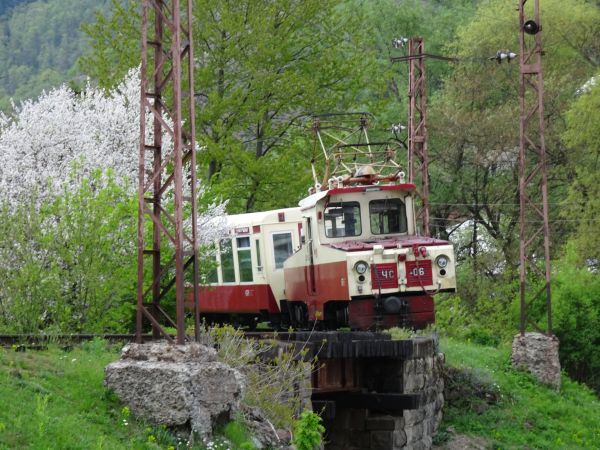
Locomotive ChS 11 no.06 with its only one passenger coach on the line.
Picture in 2019 from Borjomi by Adrian Gray.

Side view of the locomotive ChS 11 no.06.
Picture in 2019 from Borjomi by Adrian Gray.
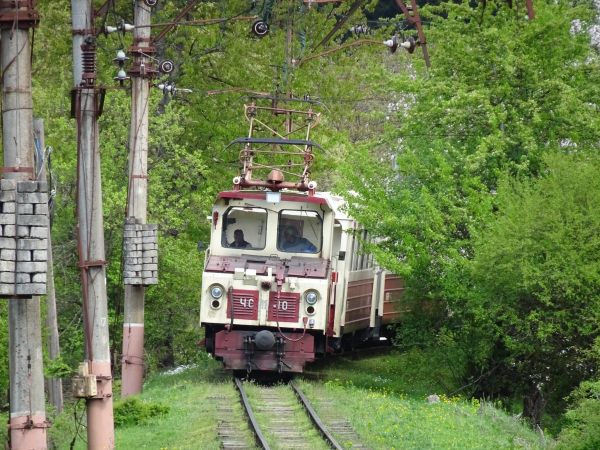
ChS 11 no 10 with two passenger coaches somewhere along the line.
Picture by Adrian Gray in 2019.

